Atlético Madrid welcomed Valencia to the Estadio Wanda Metropolitano in La Liga knowing that they would need a victory to avoid a run of three back-to-back home fixtures without a win, but they failed to secure the crucial three points.
A Denis Cheryshev handball gifted a penalty to Diego Costa shortly before half-time, with his conversion constituting his first goal on home turf since November 2018. However, following an injury to João Félix which took Atlético to 10 men, Dani Parejo scored a peach of a free-kick to equalise late on. Kang-in Lee’s late dismissal meant that neither side would end the game with all 11 players on the field.
This tactical analysis of the La Liga encounter will provide analysis of the tactics of both Diego Simeone’s Atlético Madrid and Albert Celades’ Valencia side as they played out a 1-1 draw.
Line-ups
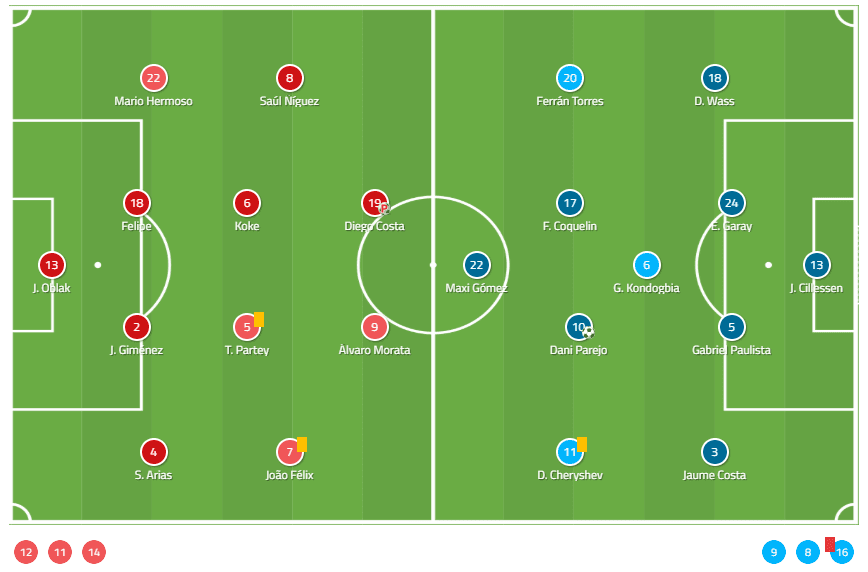
The biggest surprise in Simeone’s team selection was the decision to rest Kieran Trippier and Renan Lodi, instead of giving Santi Arias and Mario Hermoso starts at full-back. In attack, Félix lined up alongside Álvaro Morata and Diego Costa as Simeone kept his rotations to the backline.
Celades was forced into a change with Rodrigo Moreno unavailable due to injury, but he looked to add stability to his midfield as a result with Geoffrey Kondogbia coming into the team in his place. Carlos Soler also notably returned to the squad and would come on as a substitute.
Atlético’s lack of width
Without their first-choice full-backs, it was clear that Atlético were lacking their usual penetration down the flanks. The full-backs play such a crucial role in Simeone’s system due to the role of the midfield. Saúl is a central midfielder by nature and will often drift in to act as a third central midfielder, with Félix doing the same on the other flank to drop in behind the front two as a shadow striker, almost creating a diamond shape in the middle of the park. This opens up the flanks to Trippier and Lodi, or in this case, Arias and Hermoso.
However, Hermoso, in particular, struggled to adapt. It is no surprise given that he has only played three crosses since making his La Liga debut in 2017, but it is an element of Atlético’s style which is instantly removed. Hermoso would sit deeper, with Arias only bursting forwards later on in the game, and left Atlético with a very narrow approach which allowed Valencia to easily block them out with their rigid structure. With Kondogbia included for added midfield steel, Valencia had no problem in engaging in a central battle, waiting for Atlético to gamble down the flanks in a move which never came, even when Lodi was brought on as a substitute and Arias began to get more adventurous.
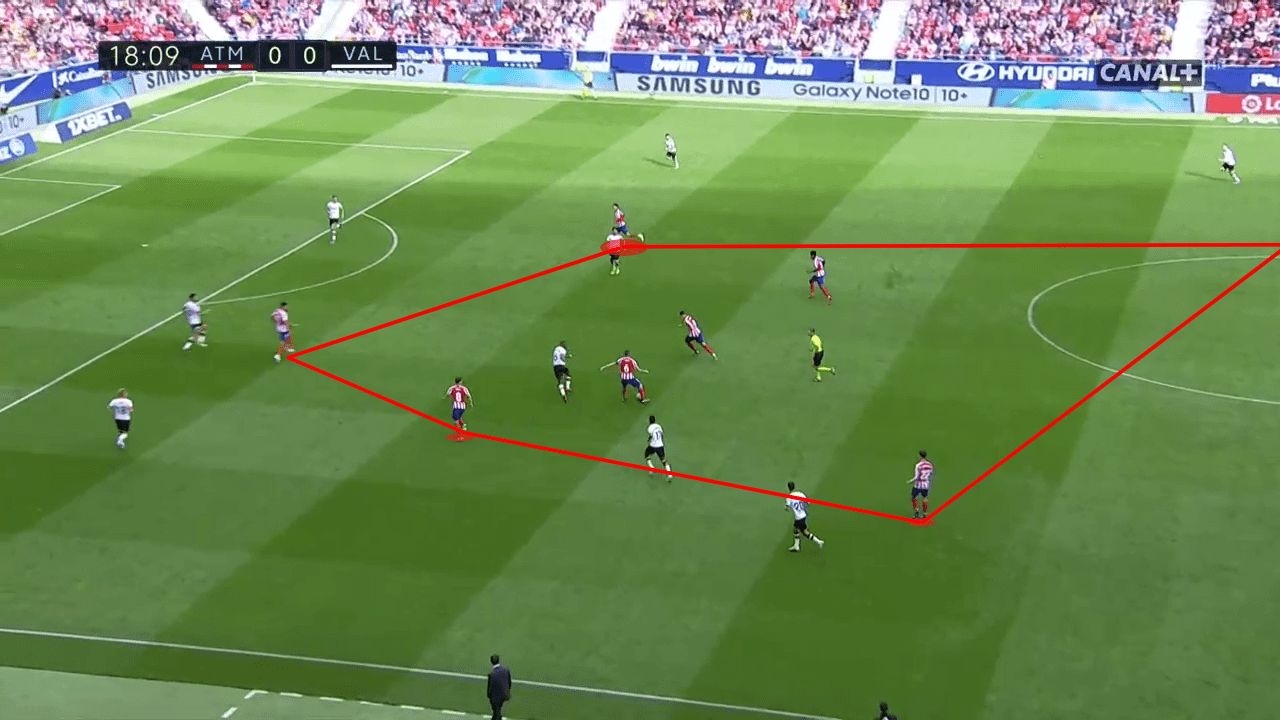
To put this solely down to the poor set-up of Atlético would be harsh, given that Valencia played their part too. Cheryshev and Ferran Torres both looked to get forward at any opportunity, often supported by their full-backs. In fact, only twice this season have Valencia made more crosses than the 16 that they made with this attacking threat down the flanks, one which adapted as the game went on as will be considered later on in this analysis as Atlético’s injury concerns took them to 10 men and allowed the wide men to change their role to have an even greater impact.
Koke concern
Atlético’s captain, Koke, has come in for criticism of late for his ineffective performances, but his display against Valencia was by far the most concerning yet. His flexibility was clear, given that he played in three different positions across the 90 minutes, but his impact was not quite so clear. With 12 possession losses, almost 30% higher than his average for the season, he also received fewer passes than in any other full 90 minutes that he has played this campaign at just 39.
Most concerning though was his positioning. Operating alongside Thomas Partey in midfield and later on next to Saúl, he would too often be found too close to his central partner. When in possession, it meant that he offered little, only simple short passes that failed to progress the ball, but when out of it, it posed a major vulnerability. As can be seen in the example below, the poor positioning of Koke alongside Thomas provided a dilemma as Parejo came onto the ball. Koke, only yards away from Thomas, should have tracked Cheryshev’s run in behind him. Failing that, he could close Parejo to narrow the passing options, as Thomas did. However, he instead did neither and stood his ground, caught out on his footing which would not allow him a quick turn and allowed the ball over the top to play in Cheryshev down the flank and create a two-on-two situation.
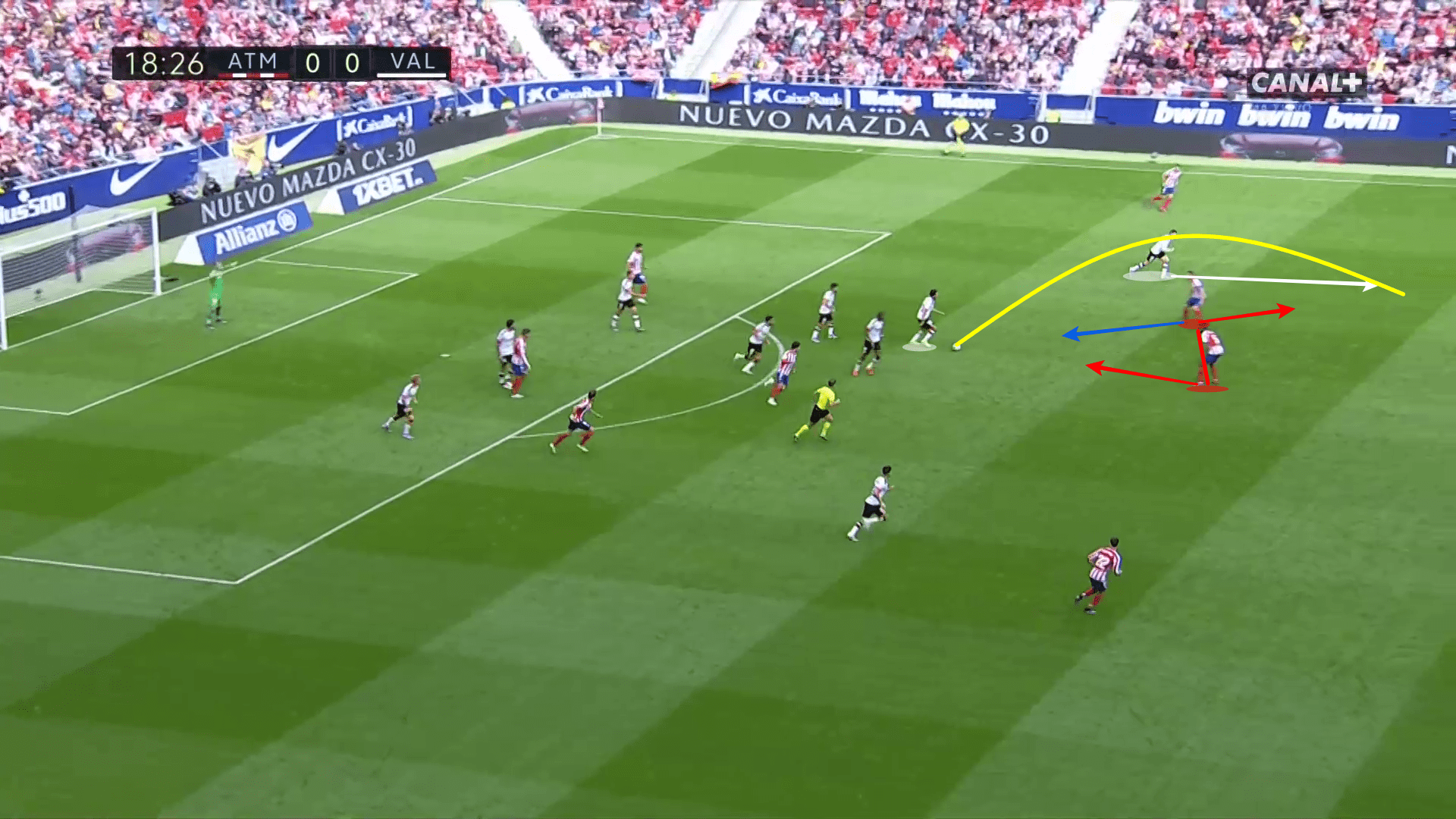
Throughout the campaign, Simeone has stuck by his first choice line-up with Saúl, Koke and Thomas. As Koke continues to adapt to this role as the team’s leader in the middle of the park, Simeone will surely have to ponder what he is doing to get the best out of the homegrown talent. By neither committing him to a defensive or offensive role, Koke is often found in no-man’s land in between Thomas behind him and Félix ahead of him. If Atlético can find his role and get the best out of him again, then it could be key to winning the midfield battle in crucial fixtures.
Simeone’s erroneous substitutions
Having identified that the midfield battle was being lost, Simeone looked to take action. However, in doing so, he committed a fatal mistake which would end up costing his team two points. After just 67 minutes, he made his third and final substitution to bring off Morata, who had won a penalty in the first half, and replace him with Marcos Llorente. Having taken Thomas off earlier in the half, it added more balance to the midfield, adding that defensive steel that had been removed and correcting his own previous mistake but also weakened the first line of defence in attack.
Morata’s withdrawal saw a significant change in that the team began to invite pressure onto themselves. Without him, the final 20 minutes of the match produced only 7% of the recoveries in the middle and final third as the press eased off. Before being injured, neither Félix nor his attacking partner Costa engaged with the Valencia defence and were prepared to allow them to have possession.
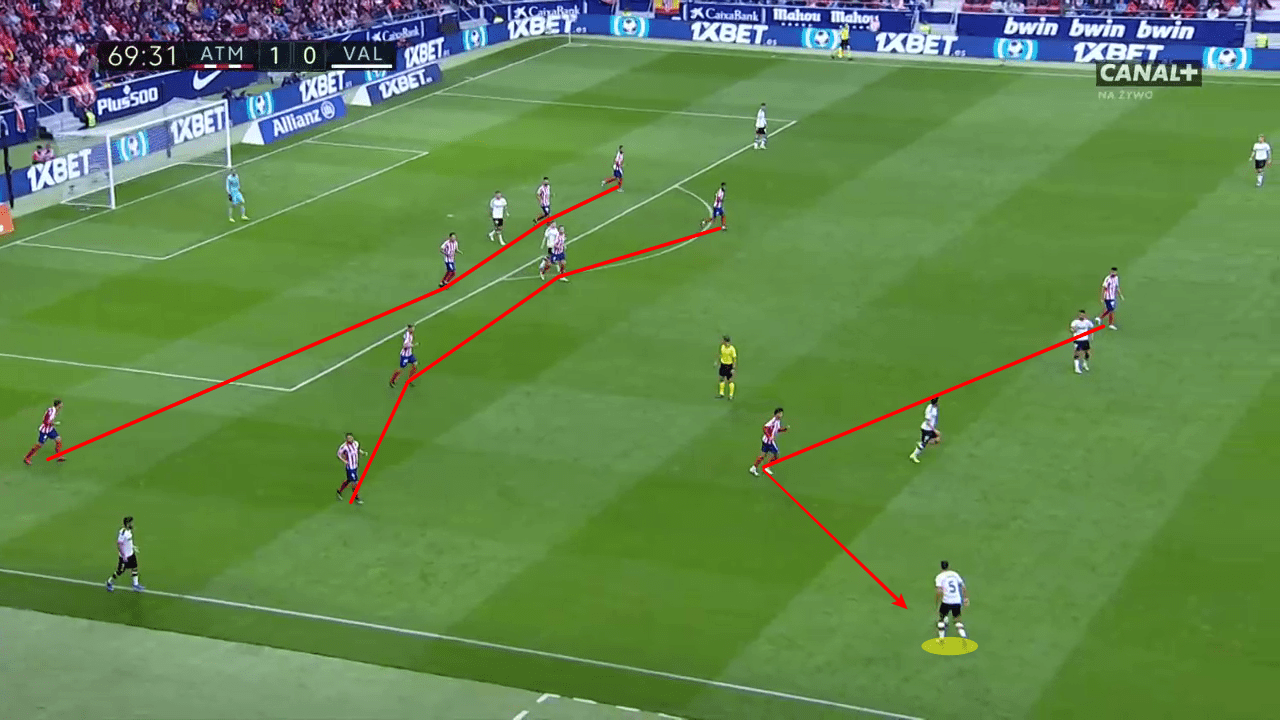
That was enhanced by the very deep midfield line which pinned Atlético back, with Llorente often being the deepest of them. That allowed Valencia to position themselves and set up camp in the Atlético half, an aspect which was only further enhanced once the hosts went down to 10 men. In this way, Llorente’s introduction served to remove crucial energy and pressing in attack and invite further pressure onto the defensive set-up. As such, whilst the central midfield battle became more balanced, it invited Valencia to find other ways through by spreading the ball wide.
Valencia exploited their man advantage
Once Atlético went down to 10 men, they switched to a logical 4-4-1 formation with Costa as the lone striker. That granted Valencia even greater freedom to build-up play from the back and commit men forwards, with Costa lacking the energy or the desire to press high and create problems. As such, both Daniel Wass and Jaume Costa could commit almost to a wing-back role where they would dedicate themselves almost exclusively to attacking commitments, serving to support the wingers ahead of them.
This proved to be crucial as it was exactly this kind of move that led to the goal. The two central defenders and two central midfielders would sit deeper, with everyone else pressing forwards ahead of them. The wingers would cut inside into the inside spaces and gaps, looking to outnumber the Atlético defence where a full-back was aware of his opposite full-back whilst the central defenders were occupied by Maxi Gómez and Kevin Gameiro. To add to the equation, Carlos Soler would make runs through to try to disrupt the midfielders dropping in to support. The result just ahead of the equaliser was a needless foul from a defensive set-up which was becoming increasingly chaotic.
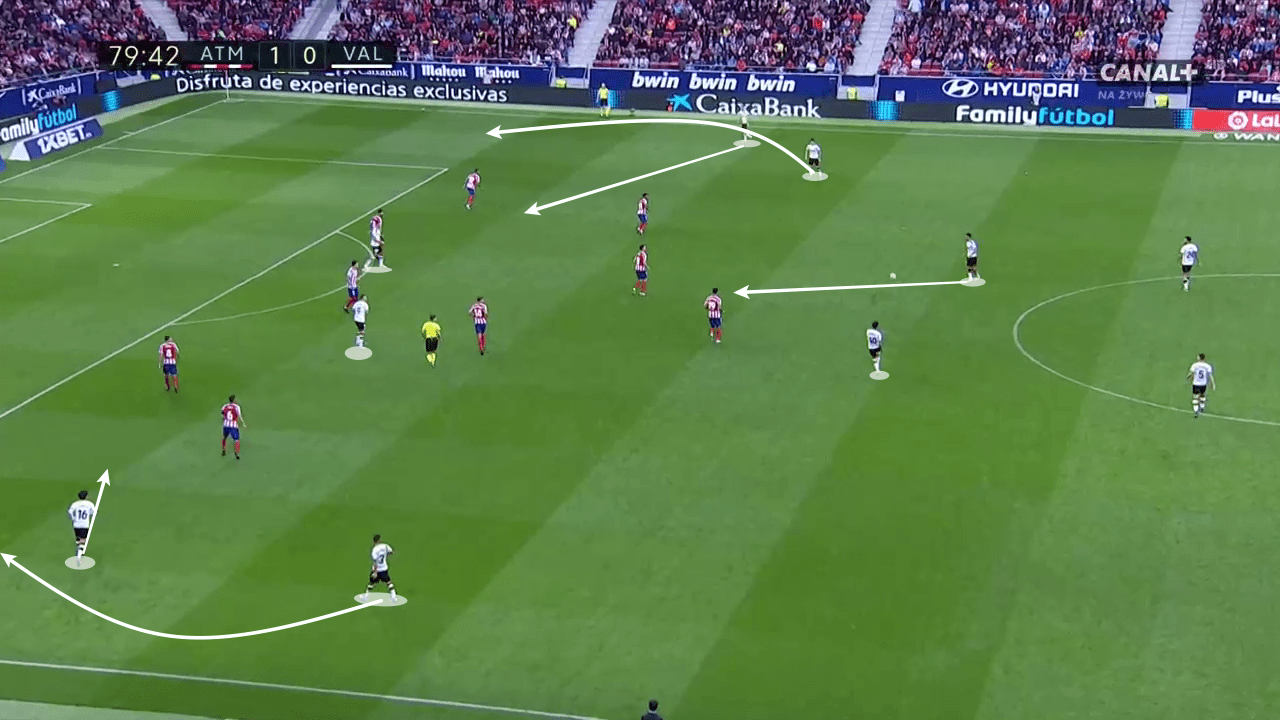
Ultimately, the dismissal of Lee for a needless and reckless challenge on the halfway line would put an end to Valencia’s approach which looked like it could have found them a late winner. Atlético had the numbers in midfield but struggled to adapt and with no outlet as Costa struggled in an isolated position, they failed to find an easy route out.
Conclusion
Ever since his appointment, it has been rare to blame Simeone for dropped points at Atlético Madrid, but this was almost certainly the case on Saturday. His decision to drop both full-backs and his substitutions continually held back the home side, who were exploited by a Valencia side who are never easy to beat and a smart approach from Celades, who reacted quickly to take advantage every time that Simeone slipped up.
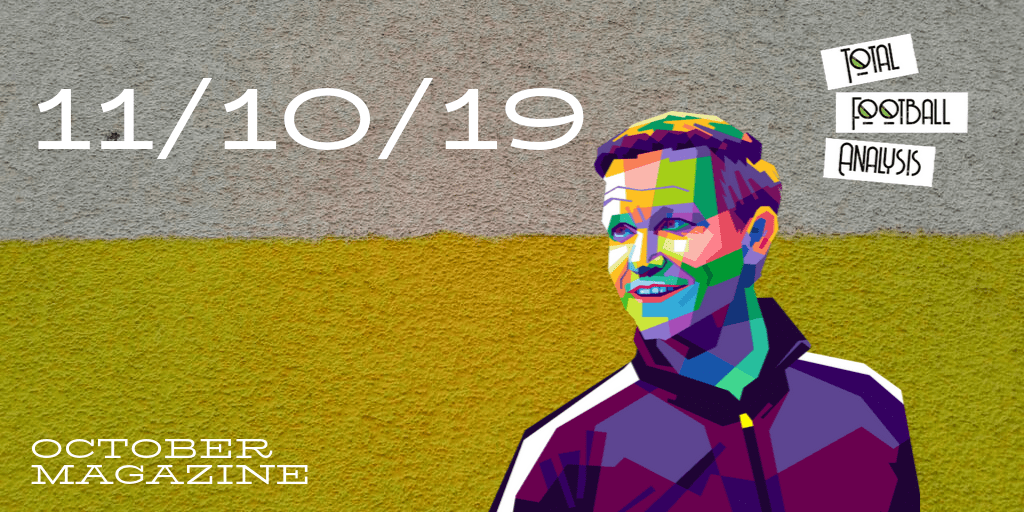
If you love tactical analysis, then you’ll love the digital magazines from totalfootballanalysis.com – a guaranteed 100+ pages of pure tactical analysis covering topics from the Premier League, Serie A, La Liga, Bundesliga and many, many more. Buy your copy of the October issue for just ₤4.99 here




Comments